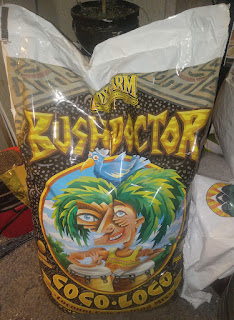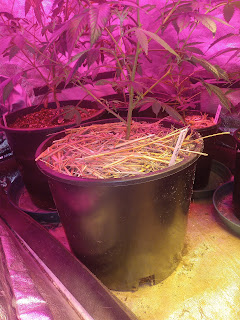Topped Plant
Once the young, vegging plants, roots are sufficiently developed, the cannabis plant will be able to uptake water and nutrients. The plant will develop quickly, resulting in an explosion of vegetative growth easily doubling in size week after week. This phase is called the Vegetative Stage.
vegetative growth
The vegetative stage for as long as the light cycle is over 12 to 14 hours every
day. So to be safe, you want to ensure that
your plants are getting at least 14 hours of light a day if you want the plant to keep growing larger, and getting larger is what the vegetative stage is all about.
The plant will only focus on developing more
stems and leaves during this time canvas plants also like an environment of around 70 to 80 degrees Fahrenheit a relative humidity range of 50-70 percent during the stage of growth, this makes the vegetative stage pretty
straightforward. You will only need to keep the plant growing until you are satisfied with the plant size.
Several things can be done during this stage of growth to maximize the potential of the plant in any given space
Transplanting to a Larger Container
The vegetative stage is when you want
your plant to move into its final container.
This means transplanting the plant into a larger container size.
For others that started the plant in its final container, you can skip this step. To transplant a plant from a seed cell or small planter, you will need to remove all the plant roots and grow medium out of its original container and then bury it into the new container the transplanted plant from a nursery bag you can bury it directly into the pot without having to
remove it since the roots have no problems growing through this bag as for what planter size to go with this is tied to the size of the plant you plan on harvesting since the size of a
the plant compared to the size of its root structure.
A three-gallon fabric pot can easily support a small to medium-sized plant a five-gallon fabric pot can easily hold a medium to large size plant.
Use a seven-gallon to grow a larger plant. It does not apply to plants growing with soil that has nutrients built into it. With these, the larger
the container, more nutrients can be taken up by the plant over time.
The more nutrients available, the longer it can feed the plant.
Daily Routing and Feed Schedule
You will need to feed your plant a growing
fertilizer rich in nitrogen.
Nitrogen is the primary nutrient needed for leaf development.
Most organic potting mixes will have plenty
of nitrogen that is built in to start.
If you are feeding with liquid fertilizer, I recommend starting at 25% of the stated dosage in the first week of the vegetative stage and then each subsequent week increase the dosage by 25 percent until you're at 100 percent.
When you notice your lower fan leaves
starting to yellow at a fast pace, you should increase the fertilizer dosage.
If you notice your fan leaves turning dark green with the tips of the leaves dying off or clawing downwards you should decrease the fertilizer dosage
healthy vegging planting
Plant Training (Topping & Low-Stress Training)
Plant training is any technique that manipulates the plant's growth pattern to fit a given space. it's needed because if left alone
cannabis plants grow similarly in shape to a
Christmas tree. It focuses all of its energy on
the tallest part of the plant. So a typical cannabis plant will have one maintop stem and several smaller side stems. Outdoors this is perfectly sufficient since the sun can still provide even lighting no matter where the side stems are resulting in a balanced growing plant.
Once the flowering stage begins indoors this is not the case as their need for light intensity will decrease exponentially. The further away you go from the source resulting in a large bud
on the top stem and much smaller buds further down the plant.
For most indoor grow spaces, the shape
is also a waste of space as most grow spots have plenty of extra horizontal room to spare. If the plant does not utilize this space light will not reach the lower nodes of the plant. So
training a plant's growth horizontally instead of vertically can ensure that the top canopy is even throughout the entire grow space which
will result in not just an increase in yields at harvest but also more consistency in the harvested bud sizes the two most popular ways to train a cannabis plant with topping and low-stress training topping means cutting off a part of the top stem to prevent the growth from
continuing through the main trunk. It will instead direct the growth to the next node down and since each node sprouts two stamps on either side, they will naturally produce
two new top stems after one topping also has the added benefit of lowering the height of the plant as the side stems are perpendicular to the main stem
While the plant can take a few days to
develop the branches on the highest node, the lower side branches will continue to form, allowing the lower stems to catch up to the top stems. A lot of times it means that just by
topping once, you get an even canopy of four
main stems.
You can top multiple times to increase the total amount of stems, although each time a plant is pruned, it takes a few days for the plant to recover. Constantly topping a plant will extend its growing timeline next, we have low-stress training which is the technique of physically bending a stem in the direction you want it to grow without breaking the stem. Tie plants using a twist tie and work great when used in conjunction with the fabric pot due to the built-in grommets that can hold the ties in place train an entire canvas plant to just bring down the main stem to the same height as the side stems. It is called low-stress training which in turn takes advantage of the fact that a canvas plant focuses its growth on the main stems located on the top of the plant. It will trick it into focusing its energy equally among all the side stems that are now suddenly at the top you can also low-stress train individual stems and bring down any stem that starts to grow higher than the ones around it low-stress training does have its limitations. Only the top
few nodes of a cannabis stem are flexible enough to be bent.
If you are considering utilizing low-stress training, you have to start early in the plant's vegetative stage and then continue applying it to any new growth if needed as the plant develops a trellis net is another form of low
stress training that automates the process by dictating a set-top canopy.
So anytime new growth appears above the
trellis net, you can push it below the netting positioning it to fill out any space that is not needed yet.
Once the trellis netting is completely
filled with plant stems, the plant can then be flowered, ensuring that all the horizontal space is used.
Leaf Defoliation
As the plant gets larger, it will start to
produce significantly more leaves than needed since in the wild several will get damaged by nature and due to the unpredictability of where the plant might be. You'll want to
ensure that it's able to capture plenty of sunlight from any side in a controlled environment, however, we know exactly where the plant is getting its light from, and because the top canopy is typically blocking all the
grow light from reaching the lower leaves. Unless you are supplementing your grill with the inner canopy lighting these leaves are going to be using up the plant's resources without providing much in return an overabundance of fan leaves will also, cause them to start overlapping trapping moisture between them and this will block airflow from reaching the inner part of the plant both of these problems will promote the growth of mold and mildew as well as creating an inviting home for pests so a light defoliation needed
any time the vegetative growth starts to
become unwieldy.
When choosing which leaves to remove,
always go with the bigger ones first.
It's easier to remove one big fan leaf than three smaller leaves touching it.
You also want to start from the bottom
up since the top leaves at the plant canopy are the ones taking in the most light. A good rule of thumb is to remove enough vegetative growth so you can see through the bottom half of your
plant.
When a Flowering plant will on average, double in height in the flowering stage, so it's necessary to flower the plant.
Once it is half the size of your available grow
space to ensure that it doesn't outgrow this
space.
It's also needed to solve any plant issues in the vegetative stage before it starts to flower as a delay in growth during the vegetative stage will just result in the plant taking a couple more days to recover while delaying growth during the flowering stage will impact the final
yields.
almost ready to flower


















